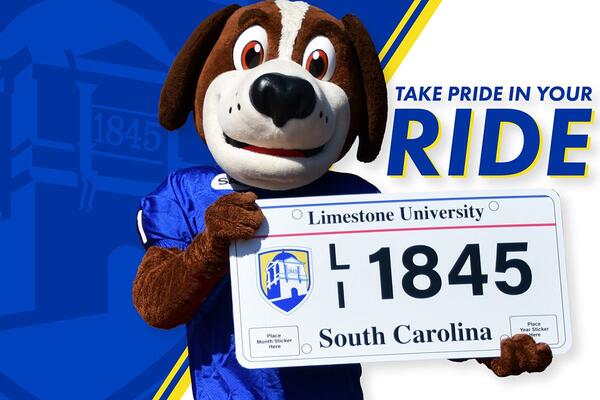February 3rd, 2022
BLACK HISTORY MONTH PROFILE: M.L. Annette Reynolds

(As part of its observance of Black History Month during February, Limestone University will be profiling some of the faculty, staff, and alumni who make The Rock such a special place. Check out our website and social media pages throughout the month as we highlight the talents, gifts, and accomplishments of some of our Saints. The annual observance of Black History Month, also known as African-American History Month across the United States, pays tribute to generations of African-Americans and the significant roles they have played in shaping our nation’s history and society.)
M.L. ANNETTE REYNOLDS: CLASS OF 1970
As a true groundbreaker in the area of racial equality, M.L. Annette Reynolds from the Class of 1970 has the distinction of being the first African-American student and graduate of Limestone. She went on to earn her Maser of Education degree from South Carolina State University.
She had a 30-year career with the Clemson University Extension Service, beginning as a 4-H agent in 1970. She retired as Cluster Director of Beaufort, Colleton, and Jasper Counties in 2000. She now resides in Florence.
Along with her career with the Extension Service, Reynolds worked in the Battered Women’s Movement as a survivor of domestic violence. Survivors helped establish shelter programs all over the United States, and she wrote a book about it entitled “Survivors Thrive.” She has now authored two books and is currently working on her third.
In 2020, Limestone University established the M.L. Annette Reynolds Endowment Fund, which will provide programmatic and student support for its diverse student body. She received an Honorary Doctor of Public Service degree from Limestone in December of 2020.
After starting her higher education journey at South Carolina State University, Reynolds got married, moved to her new husband’s hometown of Gaffney, and eventually transferred to Limestone as a junior.
“My father-in-law said, ‘Why don’t you apply to Limestone College?’ and laughed,” Reynolds recalled in a chapter she wrote in 2018 for a book that contains unique true stories about life in South Carolina. “It was really a smirk, but I didn’t catch it. I didn’t know what or where Limestone College was, but I knew I had to finish college to be a 4-H agent. So, when I was alone, I looked in the phone book and found a listing for the college. I dialed the number, and my first question was ‘Do you have a Home Economics program? The answer was ‘yes.’ This was a blessing since there were only three colleges in the state with that degree.
“My second question was ‘Where are you located?’ The college was in Gaffney, where we lived, but on the other side of town. I didn’t think about how I would get there or how I would pay for it. I simply completed the application mailed to me, included the required picture, and requested my transcripts from South Carolina State. Then I waited. I told no one. My husband and his family didn’t believe it when I told them I had been accepted. My husband said no negro was allowed on that campus. Even my father was adamantly opposed to my attending and ordered me to go back to South Carolina State. But I pushed forward.”
Reynolds went on to have a pleasant experience at Limestone, although she admits there were a few bumps along the way.
“Attending Limestone proved first a culture shock, and then a culture shift for me,” she added in the chapter of the book “Wild, Wonderful ‘n Wacky, South Carolina.” “Limestone is the first women’s college in the state, and one of the first in the nation for white women. It has a long reputation for producing excellent graduates. It would be delusional to think any success I had was the result of my being extraordinary. The simple truth is I worked hard, really hard, and I had help from others like everyone who succeeds. Daddy accustomed me to hard work. On the day that I arrived at Limestone College, all I saw was a sea of white faces. However, they were friendly and welcoming, which helped me relax.
“Mrs. Ruth Lane, my advisor helped me with my master schedule,” she continued. “She was a jewel as an advisor and as an instructor. And even though the campus was small, I still had to learn my way around. The other students were very helpful. If there were students who didn’t want me there, they did not come near me. There always seemed to be friendly students around me, and most of my instructors treated me like any other student.”
At South Carolina State as a freshman, Reynolds was a twirler for the marching band, previously known as the “Marching 100.” Once Reynolds joined the band as its very first twirler, that name changed to the “Garnet and Blue Marching 101.” She was the “one.”
During her sophomore year, her twirler photo appeared in the February 1966 issue of “Ebony” magazine. The issue’s title proclaimed, “Black Girls Are Getting Prettier,” and featured students from several different black colleges. That same year, she was secretly married and became pregnant.
Then on February 8, 1968, she said she experienced her first encounter with the racism her family and the segregated black community tried to shield her from.
“I was studying in the library that night. Just before the library closed, I walked outside and saw students, mostly guys, walking toward the front campus,” Reynolds recalled. “They carried what looked like small tree limbs. The number of people present was unusual, so I stopped two people I knew and asked what was going on. They thought a bonfire was being built.”
Moments later, Reynolds and one of her friends heard gun shots. They watched as some of their classmates fell to the ground. Her friend told her to run, and she fled to a nearby dormitory.
“I never told my parents where I had been or what I saw,” she said. “I didn’t know the students who died. We were just schoolmates. I didn’t know the high school student (who died) at all. I did know it could have been me – shot dead.”
What became known as “The Orangeburg Massacre” occurred on that night when a civil rights protest at South Carolina State University turned deadly after highway patrolmen opened fire on about 200 unarmed black student protestors. Three young men were shot and killed, and 28 people were wounded. The event is one of the most violent episodes of the civil rights movement. And Reynolds was there to see it first-hand.


